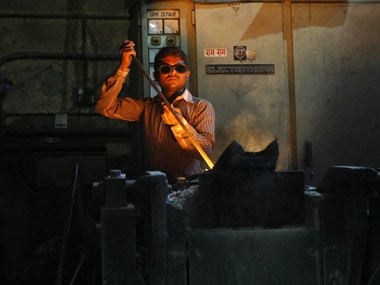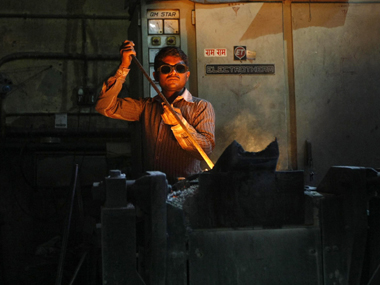The July-September Gross Domestic Product (GDP) numbers released on Monday reaffirms the belief that growth recovery is well underway in the economy. This should offer the much-needed room for the Reserve Bank of India (RBI) governor, Raghuram Rajan, to hold rates for now and watch on the inflation-front. The RBI is set to announce the fifth bi-monthly monetary policy on Tuesday at 11 am in the backdrop of a worrying pick up in the retail inflation in the recent months, especially in the prices of pulse items. The central bank is widely expected to take a pause tomorrow and watch for more cues.[caption id=“attachment_2485894” align=“alignleft” width=“380”]
 GDP booster. Reuters[/caption] The GDP, on a gross value added basis, grew at 7.4 percent in the July-September quarter compared with 7 percent in the June-quarter. A Reuters poll by analysts had forecast the GDP at 7.3 percent. The fact that growth is supported by an improvement in the manufacturing segment (9.3 percent as compared with 7.2 percent in the preceding quarter) is more encouraging. Simultaneously, the core sector numbers released on October showed a 3.2 percent growth, showing some consistency in improvement in the last three months. But on a year-on-year basis, the growth has slowed down from 9 percent earlier. Even the 3.2 percent month-on-month numbers looks weak on a closer look since the jump has been mainly contributed by a sharp spike in the cement sector growth from a negative 1.5 percent growth in September to 11.7 percent in October. More room for RBI to pause The signs of pick up in economic recovery in the recent months offer more headroom to the RBI governor to take a pause on the rate cuts and watch inflation movement in the approaching months. Rajan, who has reduced its key rates by a cumulative 125 basis points so far this year to support growth, is announcing policy amid concerns of a spike in retail inflation in recent months, especially in food prices. Thus, it is highly unlikely that Rajan will tinker with the key rates on Tuesday. The retail inflation continued to inch up, rising to 5 percent in October from 4.41 percent in September and 3.74 percent in the month before, mainly on account of price pressures on food items such as pulses. The central bank has a retail inflation target of 5.8 per cent by January, 2016. Food inflation, an important component of overall inflation, escalated to 5.25 percent in October, as compared with 3.88 percent in September and 2.20 percent in August. Pulses (such as tur dal, moong dal etc), an important item for Indian households, has risen by 42 percent in October, despite the efforts by the government in recent months to rein in the price increase through imports and by curbing hoarding. To be sure, the RBI monetary policy has, however, very little say in tackling the current price rise since it is primarily due to a supply problem. The only way out is to increase production and tackle inefficiencies in supply. But Rajan wouldn’t want to take chances by stimulating demand further, which could be inflationary. Besides, Rajan would want to wait to see the impact of a hike in interest rates by US Federal reserve in December or early next year. Boost for Modi government But, the higher-than-expected pick-up in GDP numbers in the July-September quarter is good news for the Modi government, which has been trying hard to bring back growth momentum to the economy by attracting foreign investments and clearing clogged projects in the domestic economy. The government is desperate to show that economy has indeed taken the growth path. India’s economy has remained at subdued growth rate in recent years, before started showing some pick up in the recent quarters. Even then, the pick up in the GDP numbers is yet to reflect in other key economic indicators such as bank credit growth and corporate earnings. There has been some pick up in manufacturing segment, partly on account of government spending and improvement in ground-level economic activities. But, it is too early to say the growth-recovery in the economy has taken firm hold. The stress in the economy persists with significant number of stalled projects and hardly any fresh projects coming up. “The stock of stalled projects climbed in the Sep quarter, while existing capacity is being under-utilized. This has, not surprisingly, lowered interest in green field investments, with industrial credit loan growth stagnating in single digits,” said DBS bank in a research report. Most economists expect a consumption led recovery to spearhead the economic growth going ahead, than demand-led growth with the government putting more money in the hands of people if it accepts the recommendations of the Seventh Pay Commission and One Rank One Pension proposals. This, in turn, curtails the ability of the government to invest more also due to an expected decline in corporate taxes. For now, the latest GDP numbers offer reasons for both Rajan and Modi to draw comfort. Data support by Kishor Kadam.
GDP booster. Reuters[/caption] The GDP, on a gross value added basis, grew at 7.4 percent in the July-September quarter compared with 7 percent in the June-quarter. A Reuters poll by analysts had forecast the GDP at 7.3 percent. The fact that growth is supported by an improvement in the manufacturing segment (9.3 percent as compared with 7.2 percent in the preceding quarter) is more encouraging. Simultaneously, the core sector numbers released on October showed a 3.2 percent growth, showing some consistency in improvement in the last three months. But on a year-on-year basis, the growth has slowed down from 9 percent earlier. Even the 3.2 percent month-on-month numbers looks weak on a closer look since the jump has been mainly contributed by a sharp spike in the cement sector growth from a negative 1.5 percent growth in September to 11.7 percent in October. More room for RBI to pause The signs of pick up in economic recovery in the recent months offer more headroom to the RBI governor to take a pause on the rate cuts and watch inflation movement in the approaching months. Rajan, who has reduced its key rates by a cumulative 125 basis points so far this year to support growth, is announcing policy amid concerns of a spike in retail inflation in recent months, especially in food prices. Thus, it is highly unlikely that Rajan will tinker with the key rates on Tuesday. The retail inflation continued to inch up, rising to 5 percent in October from 4.41 percent in September and 3.74 percent in the month before, mainly on account of price pressures on food items such as pulses. The central bank has a retail inflation target of 5.8 per cent by January, 2016. Food inflation, an important component of overall inflation, escalated to 5.25 percent in October, as compared with 3.88 percent in September and 2.20 percent in August. Pulses (such as tur dal, moong dal etc), an important item for Indian households, has risen by 42 percent in October, despite the efforts by the government in recent months to rein in the price increase through imports and by curbing hoarding. To be sure, the RBI monetary policy has, however, very little say in tackling the current price rise since it is primarily due to a supply problem. The only way out is to increase production and tackle inefficiencies in supply. But Rajan wouldn’t want to take chances by stimulating demand further, which could be inflationary. Besides, Rajan would want to wait to see the impact of a hike in interest rates by US Federal reserve in December or early next year. Boost for Modi government But, the higher-than-expected pick-up in GDP numbers in the July-September quarter is good news for the Modi government, which has been trying hard to bring back growth momentum to the economy by attracting foreign investments and clearing clogged projects in the domestic economy. The government is desperate to show that economy has indeed taken the growth path. India’s economy has remained at subdued growth rate in recent years, before started showing some pick up in the recent quarters. Even then, the pick up in the GDP numbers is yet to reflect in other key economic indicators such as bank credit growth and corporate earnings. There has been some pick up in manufacturing segment, partly on account of government spending and improvement in ground-level economic activities. But, it is too early to say the growth-recovery in the economy has taken firm hold. The stress in the economy persists with significant number of stalled projects and hardly any fresh projects coming up. “The stock of stalled projects climbed in the Sep quarter, while existing capacity is being under-utilized. This has, not surprisingly, lowered interest in green field investments, with industrial credit loan growth stagnating in single digits,” said DBS bank in a research report. Most economists expect a consumption led recovery to spearhead the economic growth going ahead, than demand-led growth with the government putting more money in the hands of people if it accepts the recommendations of the Seventh Pay Commission and One Rank One Pension proposals. This, in turn, curtails the ability of the government to invest more also due to an expected decline in corporate taxes. For now, the latest GDP numbers offer reasons for both Rajan and Modi to draw comfort. Data support by Kishor Kadam.
GDP at 7.4%: Why better-than-expected growth is good news for both Modi and Rajan
Dinesh Unnikrishnan
• November 30, 2015, 20:55:27 IST
Food inflation, an important component of overall inflation, escalated to 5.25 percent in October, as compared with 3.88 percent in September and 2.20 percent in August.
Advertisement
)
End of Article